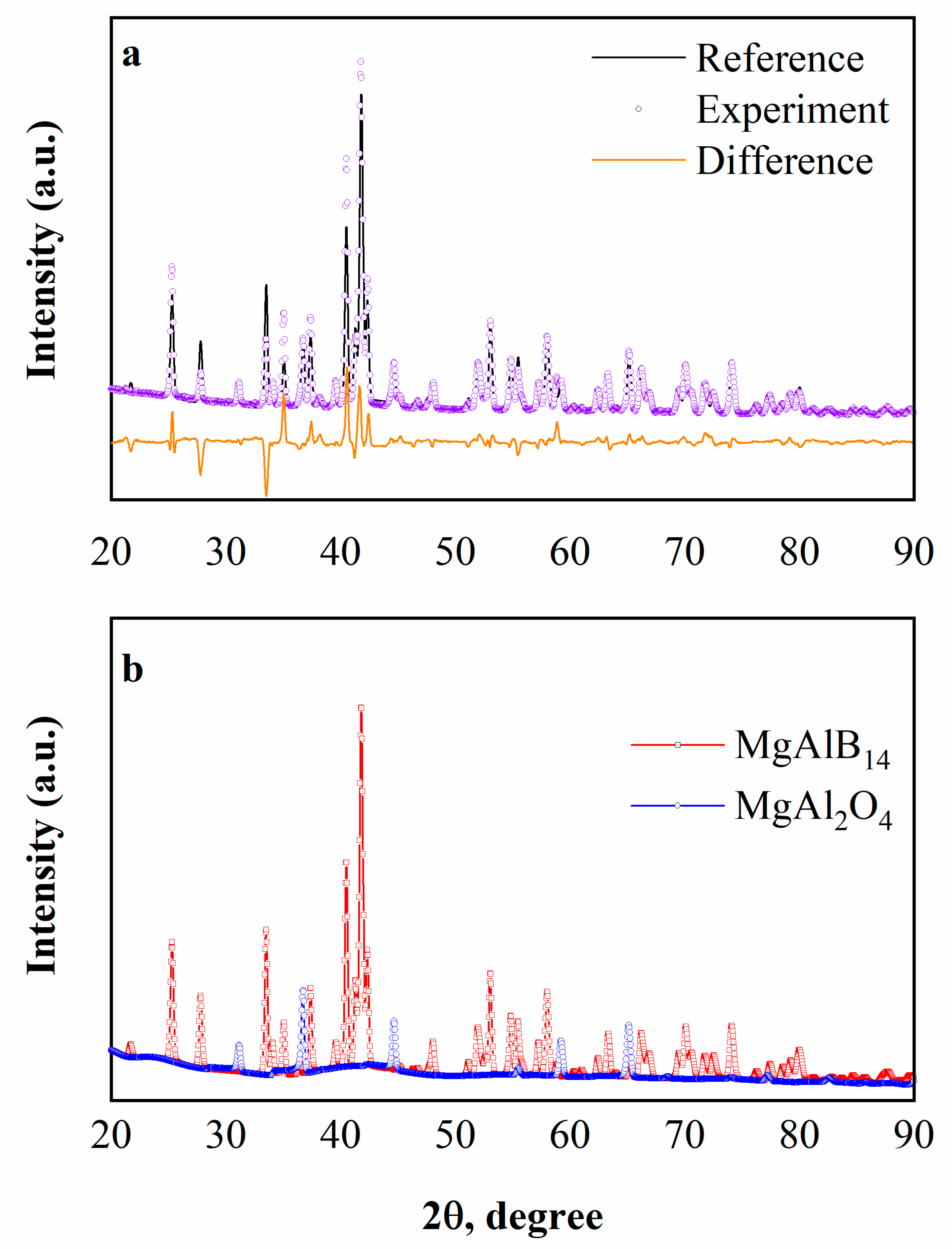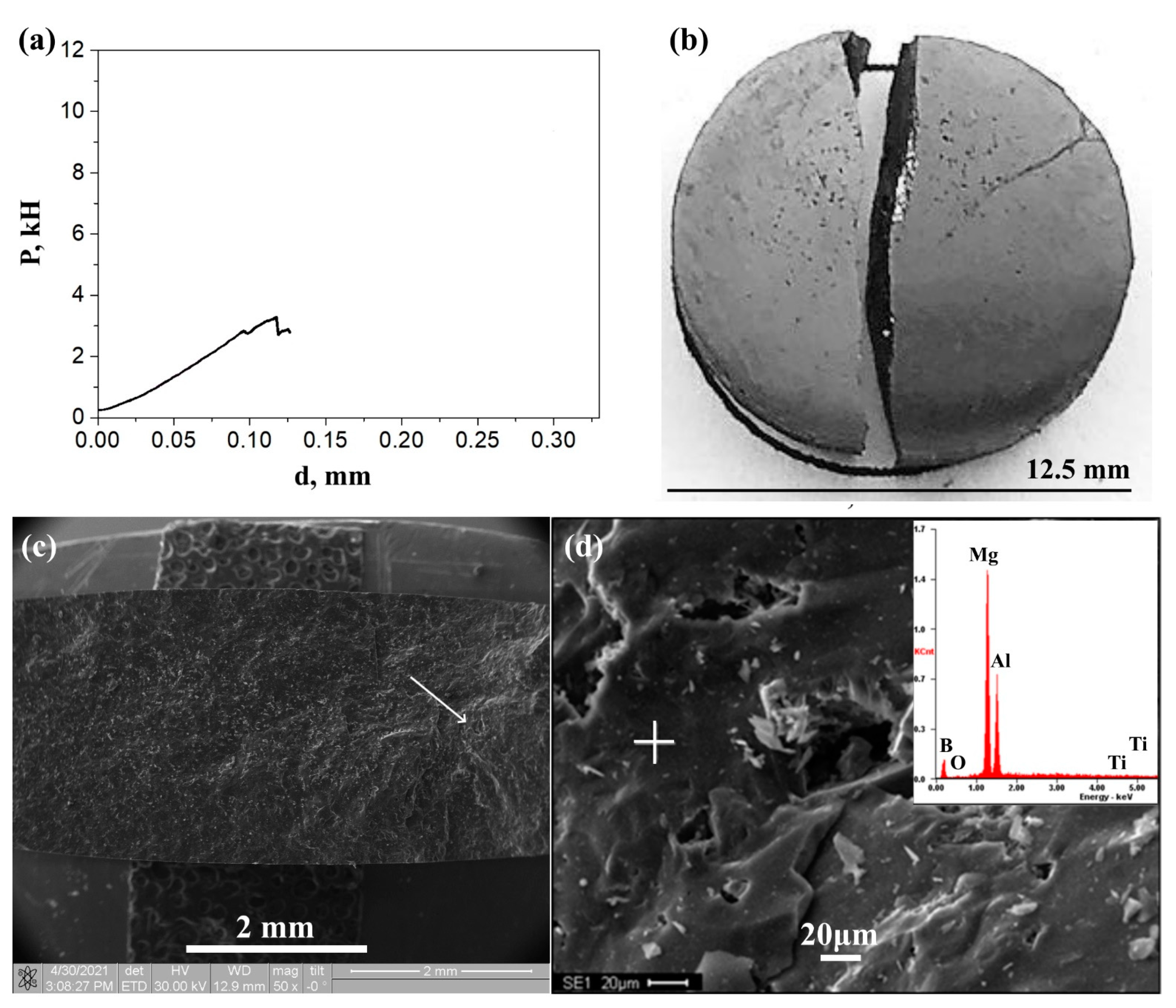On the Tensile Strength of Spark Plasma Sintered AlMgB14 Ceramics
Abstract
:1. Introduction
2. Materials and Methods
2.1. Process for Obtaining AlMgB14-Based Ceramics
2.2. Brazilian Test
2.3. Characterization
3. Results
3.1. Microstructure and Phase Composition of the Obtained AlMgB14 Ceramics
3.2. Mechanical Properties of the Sintered Sample
4. Discussion
5. Conclusions
Supplementary Materials
Author Contributions
Funding
Data Availability Statement
Acknowledgments
Conflicts of Interest
References
- Wentorf, R.H.; DeVries, R.C.; Bundy, F.P. Sintered Superhard Materials. Science 1980, 208, 873–880. [Google Scholar] [CrossRef] [PubMed]
- Cook, B.A.; Harringa, J.L.; Lewis, T.L.; Russel, A.M. A new class of ultra-hard materials based on AlMgB14. Scr. Mater. 2000, 42, 597–602. [Google Scholar] [CrossRef] [Green Version]
- Nguyen, T.P.; Mahaseni, Z.H.; Germi, M.D.; Delbari, S.A.; Van Le, Q.; Ahmadi, Z.; Namini, A.S. Densification behavior and microstructure development in TiB2 ceramics doped with h-BN. Ceram. Int. 2020, 46, 18970–18975. [Google Scholar] [CrossRef]
- Matveev, A.E.; Zhukov, I.A.; Ziatdinov, M.H.; Zhukov, A.S. Planetary Milling and Self-Propagating High-Temperature Synthesis of Al-TiB2 Composites. Material 2020, 13, 1050. [Google Scholar] [CrossRef] [PubMed] [Green Version]
- Matveev, A.; Promakhov, V.; Nikitin, P.; Babaev, A.; Vorozhtsov, A. Effect of Mechanical Activation of Al-Ti-B Powder Mixture on Phase Composition and Structure of Al-TiB2 Composite Materials Obtained by Self-Propagating High-Temperature Synthesis (SHS). Materials 2022, 15, 2668. [Google Scholar] [CrossRef]
- Promakhov, V.; Matveev, A.; Schulz, N.; Dronov, P.; Zhukov, A.; Vorozhtsov, A. Structure, Properties and Phase Composition of Composite Materials Based on the System NiTi-TiB2. Materials 2022, 15, 5327. [Google Scholar] [CrossRef]
- Evseev, N.S.; Matveev, A.E.; Nikitin, P.Y.; Abzaev, Y.A.; Zhukov, I.A. A theoretical and experimental investigation on the SHS synthesis of (HfTiCN)-TiB2 high-entropy composite. Ceram. Int. 2022, 48, 16010–16014. [Google Scholar] [CrossRef]
- Pant, H.K.; Debnath, D.; Chakraborty, S.; Wani, M.F.; Das, P.K. Mechanical and tribological properties of spark plasma sintered SiC–TiB2 and SiC–TiB2–TaC composites: Effects of sintering temperatures (2000 °C and 2100 °C). J. Tribol. 2018, 140, 011608. [Google Scholar] [CrossRef]
- Vallauri, D.; Adrián, I.A.; Chrysanthou, A. TiC–TiB2 composites: A review of phase relationships, processing and properties. J. Eur. Ceram. Soc. 2008, 28, 1697–1713. [Google Scholar] [CrossRef]
- Matveev, A.E.; Nikitin, P.Y.; Zhukov, I.A.; Zhukov, A.S. The use of plastic waste as carbon raw materials to obtain TiC-based powders. Ceram. Int. 2021, 47, 21140–21146. [Google Scholar] [CrossRef]
- Liao, F.; Girshick, S.L.; Mook, W.M.; Gerberich, W.W.; Zachariah, M.R. Superhard nanocrystalline silicon carbide films. Appl. Phys. Lett. 2005, 86, 171913. [Google Scholar] [CrossRef] [Green Version]
- Teter, D.M. Computational alchemy: The search for new superhard materials. MRS Bull. 1998, 23, 22–27. [Google Scholar] [CrossRef]
- Lowther, J.E. Possible ultra-hard materials based upon boron icosahedra. Phys. B Condens. Matter 2002, 322, 173–178. [Google Scholar] [CrossRef]
- Kevorkijan, S.D.; Škapin, M.; Jelen, K.; Krnel, A. Meden, Cost-effective synthesis of AlMgB14–xTiB2. J. Eur. Ceram. Soc. 2007, 27, 493–497. [Google Scholar] [CrossRef]
- Xie, Z.; DeLucca, V.; Haber, R.A.; Restrepo, D.T.; Todd, J.; Blair, R.G.; Orlovskaya, N. Aluminum magnesium boride: Synthesis, sintering and microstructure. Adv. Appl. Ceram. 2017, 116, 341–347. [Google Scholar] [CrossRef]
- Roberts, D.J.; Zhao, J.; Munir, Z.A. Mechanism of reactive sintering of MgAlB14 by pulse electric current. Int. J. Refract. Hard Met. 2009, 27, 556–563. [Google Scholar] [CrossRef]
- Nikitin, P.Y.; Zhukov, I.A.; Matveev, A.E.; Sokolov, S.D.; Boldin, M.S.; Vorozhtsov, A.B. AlMgB14–TiB2 composite materials obtained by self-propagating high-temperature synthesis and spark plasma sintering. Ceram. Int. 2020, 46, 22733–22737. [Google Scholar] [CrossRef]
- Nikitin, P.Y.; Matveev, A.E.; Zhukov, I.A. Energy-effective AlMgB14 production by self-propagating high-temperature synthesis (SHS) using the chemical furnace as a source of heat energy. Ceram. Int. 2021, 47, 21698–21704. [Google Scholar] [CrossRef]
- Chen, J.; Cheng, J.; Li, F.; Zhu, S.; Li, W.; Yang, J.; Liu, W. Tribological study on a novel wear-resistant AlMgB14-Si composite. Ceram. Int. 2017, 43, 12362–12371. [Google Scholar] [CrossRef]
- Zhukov, I.A.; Ziatdinov, M.K.; Dubkova, Y.A.; Nikitin, P.Y. Synthesis of AlMgB14: Influence of Mechanical Activation of Al–Mg–B Powder Mixture on Phase Composition of Sintered Materials. Russ. Phys. J. 2018, 61, 1466–1471. [Google Scholar] [CrossRef]
- Zhukov, I.A.; Nikitin, P.Y.; Vorozhtsov, A.B.; Perevislov, S.N.; Sokolov, S.D.; Ziatdinov, M.H. The use of intermetallic AlxMgy powder to obtain AlMgB14-based materials. Mater. Today Commun. 2020, 22, 100848. [Google Scholar] [CrossRef]
- Nikitin, P.Y.; Zhukov, I.A.; Vorozhtsov, A.B. Decomposition mechanism of AlMgB14 during the spark plasma sintering. J. Mater. Res. Technol. 2020, 11, 687–692. [Google Scholar] [CrossRef]
- Nikitin, P.; Zhukov, I.; Matveev, A.; Sokolov, S.; Grigoriev, M.; Vorozhtsov, A. On the Structure and Properties of AlMgB14-TiB2 Composites Obtained from SHS Powders by Spark Plasma Sintering. Materials 2021, 14, 5521. [Google Scholar] [CrossRef]
- Nikitin, P.; Zhukov, I.; Matveev, A.; Sokolov, S.; Sachkov, V.; Vorozhtsov, A. Phase Composition, Structure and Properties of the Spark Plasma Sintered Ceramics Obtained from the Al12Mg17-B-Si Powder Mixtures. Nanomaterials 2022, 12, 1895. [Google Scholar] [CrossRef] [PubMed]
- Cheng, J.; Ma, J.; Li, F.; Qiao, Z.; Yang, J.; Liu, W. Dry-sliding tribological properties of Cu/AlMgB14 composites. Tribol. Lett. 2014, 55, 35–44. [Google Scholar] [CrossRef]
- Sun, Y.Y.; Zhang, P.X.; Liu, G.Q.; Xiong, X.M.; Yang, F.; Jiao, G.F.; Yan, G. Effect of two-step heat treatment on the phase formation of MgAlB14. Mater. Lett. 2011, 65, 2158–2160. [Google Scholar] [CrossRef]
- Lewis, T.L.; Cook, B.A.; Harringa, J.L.; Russell, A.M. Al2MgO4, Fe3O4, and FeB impurities in AlMgB14. Mater. Sci. Eng. A 2003, 351, 117–122. [Google Scholar] [CrossRef]
- Russell, A.M.; Cook, B.A.; Harringa, J.L.; Lewis, T.L. Coefficient of thermal expansion of AlMgB14. Scr. Mater. 2002, 46, 629–633. [Google Scholar] [CrossRef]
- Aliha, M.R.M.; Ayatollahi, M.R. Analysis of fracture initiation angle in some cracked ceramics using the generalized maximum tangential stress criterion. Int. J. Solids Struct. 2012, 49, 1877–1883. [Google Scholar] [CrossRef] [Green Version]
- Brückner-Foit, A.; Fett, T.; Munz, D.; Schirmer, K. Discrimination of multiaxiality criteria with the Brazilian disc test. J. Eur. Ceram. Soc. 1997, 17, 689–696. [Google Scholar] [CrossRef]
- Clark, S.J.; Segall, M.D.; Pickard, C.J.; Hasnip, P.J.; Probert, M.I.; Refson, K.; Payne, M.C. First principles methods using CASTEP. Z. Für Krist.-Cryst. Mater. 2005, 220, 567–570. [Google Scholar] [CrossRef] [Green Version]
- Perdew, J.P.; Burke, K.; Ernzerhof, M. Generalized gradient approximation made simple. Phys. Rev. Lett. 1996, 77, 3865. [Google Scholar] [CrossRef] [PubMed] [Green Version]
- Carmona, S.; Aguado, A. New model for the indirect determination of the tensile stress–strain curve of concrete by means of the Brazilian test. Mater. Struct. 2012, 45, 1473–1485. [Google Scholar] [CrossRef]
- Colback, P.S.B. An analysis of brittle fracture initiation and propagation in the Brazilian test. In Proceedings of the 1st ISRM Congress, Lisbon, Portugal, 25 September–1 October 1966. [Google Scholar]
- García, V.J.; Márquez, C.O.; Zúñiga-Suárez, A.R.; Zuñiga-Torres, B.C.; Villalta-Granda, L.J. Brazilian test of concrete specimens subjected to different loading geometries: Review and new insights. Int. J. Concr. Struct. Mater. 2017, 11, 343–363. [Google Scholar] [CrossRef] [Green Version]
- Serati, M.; Masoumi, H.; Williams, D.J.; Alehossein, H. Modified Brazilian test for indirect measurement of tensile strength of brittle materials. In Proceedings of the 51st US Rock Mechanics/Geomechanics Symposium, San Francisco, CA, USA, 25–28 June 2017. [Google Scholar]
- Dai, Y.; Li, Y.; Xu, X.; Zhu, Q.; Yan, W.; Jin, S.; Harmuth, H. Fracture behaviour of magnesia refractory materials in tension with the Brazilian test. J. Eur. Ceram. Soc. 2019, 39, 5433–5441. [Google Scholar] [CrossRef]
- Cook, B.A.; Russell, A.M.; Peters, J.; Harringa, J.L. Estimation of surface energy and bonding between AlMgB14 and TiB2. J. Phys. Chem. Solids 2010, 71, 824–826. [Google Scholar] [CrossRef]
- Pastor, J.Y.; Poza, P.; Llorca, J.; Pena, J.I.; Merino, R.I.; Orera, V.M. Mechanical properties of directionally solidified Al2O3–ZrO2 (Y2O3) eutectics. Mater. Sci. Eng. A 2001, 308, 241–249. [Google Scholar] [CrossRef]
- Zhang, X.; Luo, X.; Li, J.; Hu, P.; Han, J. The ideal strength of transition metal diborides TMB2 (TM = Ti, Zr, Hf): Plastic anisotropy and the role of prismatic slip. Scr. Mater. 2010, 62, 625–628. [Google Scholar] [CrossRef]



| Powder | Average Particle Size | Purity, % |
|---|---|---|
| Al12Mg17 | 15 μm | ≥99.2 |
| Amorphous B | 600 nm | ≥98.7 |
| MA-Al12Mg17-B | 400 nm | ≥98.8 |
| Phase | State | a, Å | b, Å | c, Å | α = β = γ | V, Å3 | E, eV |
|---|---|---|---|---|---|---|---|
| AlMgB14 | Reference | 5.850 | 8.111 | 10.310 | 90 | 489.202 | −8451.883 |
| Refined | 5.851 | 8.112 | 10.311 | 90 | 489.394 | −8451.884 | |
| MgAl2O4 | Reference | 8.083 | 8.083 | 8.083 | 90 | 528.101 | −22767.860 |
| Refined | 8.045 | 8.045 | 8.045 | 90 | 520.688 | −22767.475 |
| Measurement Number/HV | HVav, GPa | |||||||||
|---|---|---|---|---|---|---|---|---|---|---|
| 1 | 2 | 3 | 4 | 5 | 6 | 7 | 8 | 9 | 10 | 29.00 ± 0.88 |
| 2743.9 | 2795.6 | 2858.0 | 3050.8 | 2903.4 | 2805.4 | 2795.6 | 2931.3 | 3073.3 | 3073.3 | |
| Element | B | Al | Mg | O | Ti |
|---|---|---|---|---|---|
| Wt% | 87.6 | 4.10 | 8.00 | 0.25 | 0.05 |
Publisher’s Note: MDPI stays neutral with regard to jurisdictional claims in published maps and institutional affiliations. |
© 2022 by the authors. Licensee MDPI, Basel, Switzerland. This article is an open access article distributed under the terms and conditions of the Creative Commons Attribution (CC BY) license (https://creativecommons.org/licenses/by/4.0/).
Share and Cite
Nikitin, P.; Zhukov, I.; Tkachev, D.; Kozulin, A.; Vorozhtsov, A. On the Tensile Strength of Spark Plasma Sintered AlMgB14 Ceramics. Nanomaterials 2022, 12, 3805. https://doi.org/10.3390/nano12213805
Nikitin P, Zhukov I, Tkachev D, Kozulin A, Vorozhtsov A. On the Tensile Strength of Spark Plasma Sintered AlMgB14 Ceramics. Nanomaterials. 2022; 12(21):3805. https://doi.org/10.3390/nano12213805
Chicago/Turabian StyleNikitin, Pavel, Ilya Zhukov, Dmitrii Tkachev, Alexander Kozulin, and Alexander Vorozhtsov. 2022. "On the Tensile Strength of Spark Plasma Sintered AlMgB14 Ceramics" Nanomaterials 12, no. 21: 3805. https://doi.org/10.3390/nano12213805





